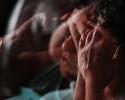If you have difficulty understanding your OCD, or have difficulty trying to help someone else understand it, a diagram from the book Anxiety Free: Unravel Your Fears Before They Unravel You by Robert L Leahy, Ph.D., may help bring clarity.
The OCD Thought Process
- A Trigger. A stimulus or event - such as touching something, going to bed, or thinking about sex - sets off or triggers the OCD process.
- Intrusive/Odd Thoughts or Images. You experience unwanted, distressing sensations or thoughts (e.g., sick, irrational, bizarre, disgusting, horrifying).
- Negative Evaluation. You believe that having these thoughts means there is something wrong with you, that you should not think or feel the way you do. You set yourself on a mission to control or get rid of the thoughts, or find reassurance.
- Watching Yourself. You constantly monitor yourself for these thoughts so naturally, you will find yourself thinking them.
- Needing Certainty. An urge arises to know, without doubt, that you will not lose control, or act out your thoughts.
- Fusion of Thought-Action. In your mind you are equating the presence of a thought with acting on that thought. For instance, “If I think about hurting someone, I will hurt someone.” Or, “If I think I’m contaminated, I must be contaminated.”
- Suppressing the Thoughts. You react to the unwanted thoughts first by trying to stop or suppress them, which at best will be successful for a few minutes.
- Sensing Loss of Control. Because the thoughts cannot be stopped you feel anxious, out of control. Regaining control means eliminating the distressing thoughts.
- Compulsive Behavior. To eliminate the disturbing thoughts and reduce anxiety you now perform a ritual meant to neutralize the thoughts (e.g., praying, hand washing, repeated checking, counting, touching things a certain way).
- Sensing Completion. At some point you feel the ritual is completed; you have done enough to ease your distress. Because the ritual relieved the anxiety, you will use it again.
- Avoiding Triggers. Since the whole process starts with specific triggers, you make a point of avoiding whatever triggers the unwelcome thoughts—such as public restrooms, shaking hands, eating in restaurants, certain types of movies, or books.
This is how people with OCD think, after being triggered, so they can continue being a responsible person. Unfortunately, though the process provides temporary anxiety relief, it never provides a solution. The solution lies in understanding OCD, and finding the professional support to process unwanted thoughts differently and effectively.
Photo credit: Robert Couse-Baker - flickr







